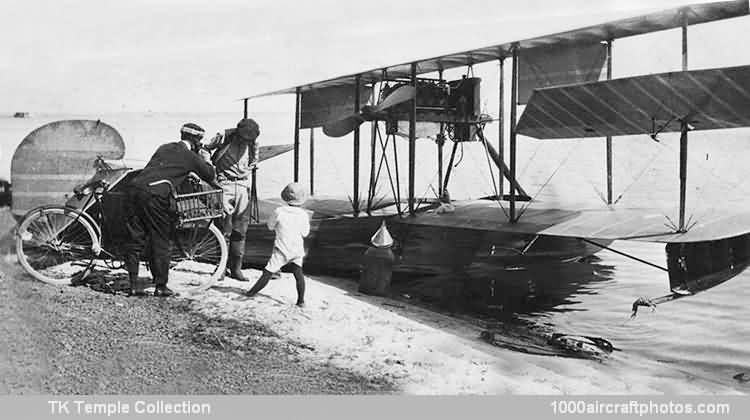09/30/2012. Remarks by Johan Visschedijk: "The 1913 Model F two-seat flying boat used the early composite hull construction and what were essentially Model E wings with strut-braced extensions of the upper wing, power plant was a 75 hp Curtiss O pusher engine. Because of its many 'old' features relative to the 1914 F-boat, the 1913 model has sometimes (and erroneously) been referred to by historians as the E-boat in disregard of the recognized Curtiss Model E landplane and the USN's E-designation.
The standardized 1914 Model F differed noticeably from the 1913 versions, particularly in having equal-span wings with rounded tips projecting beyond the end struts and a hull with full-depth primary structure and a rounded wood veneer foredeck. On some civil models, the foredeck hinged forward to form a gangplank for crew movement to or from a beach. An additional feature was a diagonal strut from the engine mount to the lower forward hull structure, intended to protect the crew from a falling engine in a crash. This became known as the Goodier strut since it was installed as the result of US Army Lieutenant Lewis Goodier's crash in the Army's first F-boat, S.C.15.
While producing the standard F-boat for the open market, Curtiss also built custom-designed flying boats to special order. These were usually named to the preferences of their owner rather than being given Curtiss designations. To the end of 1916 the USN ordered twelve examples of the basic F-boat (s/n A-386, A-387, A-390 to A-393, A408, A-752 to A-756).
After US entry into the war in May 1917 the design was chosen as the USN's standard primary training flying boat and another 144 were procured (s/n A-2277, A-2279 to A-2281, A-2295 to A-2344, A-3328 to A-3332, A-4079 to A-4108, A-4349 to A-4402, A-5258). View also photo 8988 and 9435. Production continued into 1918 until replaced by the MF, yet the F was overlooked in the 1935 redesignation.
The 1917-18 Model Fs were greatly improved over the 1914 model, the principal change being redesign of the control system to delete the shoulder-yoke aileron control, both Services having agreed to standardize on the Deperdussin system in August 1916. Various wing modifications were tried on a few examples, among them extension of the upper wing span and transfer of the interplane ailerons to the upper wing. Several F-boats were fitted out as aerial ambulances, with provision for a litter to be carried on top of the hull behind the cockpit. Power plant was the 100 hp Curtiss OXX-3.
Costing $7,500, less GFE, new, surplus F-boats came on the postwar market priced at $1,750 and saw relatively wide use by private owners."
